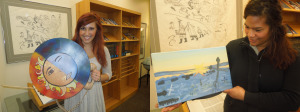 This group project was done for a course deliberately designed to challenge assumptions made about the history and culture of Alaska Natives. In the class, I ask: Is it possible to find or understand another’s truth through the lens of history and culture?
This group project was done for a course deliberately designed to challenge assumptions made about the history and culture of Alaska Natives. In the class, I ask: Is it possible to find or understand another’s truth through the lens of history and culture?
By the end of the course, I expect that participants will understand and be able to articulate why Alaska’s Native problems have never been solved. Students examine historical impacts of government policies on Alaska Native cultures and communities, and celebrate the incredible resilience of Alaska’s “original inhabitants. “
Daisy Greer (Early Honors) and Amanda Sasieta (Education) were very moved by Frontline’s video, “Silence,” which is about the impacts of sexual abuse by a Catholic priest and a layman in villages in western Alaska. Daisy and Amanda decided to do an art presentation to reflect what spoke to them individually about the issues raised by this video.
Daisy went the Alaska Native Heritage Center to learn how to make a drum, and painted the sun and moon communicating with each other. She contemporized the drum with an old phone handle and cord found in her neighbor’s yard, which she attached to the drum and the stick in her father’s wood shop. She loved the resilience shown in the dancing and drumming, and wanted to reflect the courage of those who broke the silence and helped others begin to heal.
Amanda was so moved by the image of the graveyard in St. Michael, she froze the frame and painted a picture of the graveyard. The shades of blue in Amanda’s painting reflect the sadness and pain inflicted by the Priest’s abuse on the community of St. Michael. It is hauntingly beautiful.
—Victoria Hykes Steere, Assistant Professor of Alaska Native Studies
